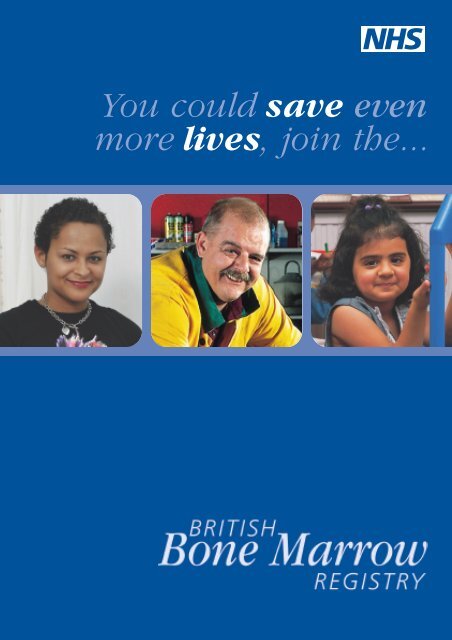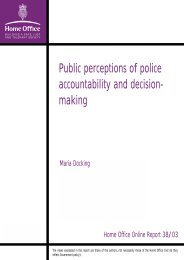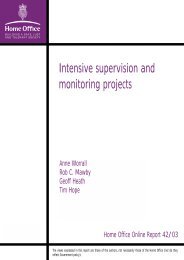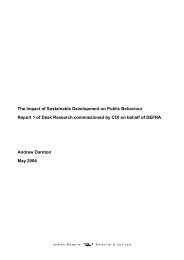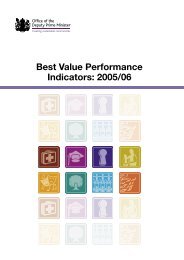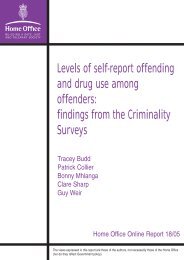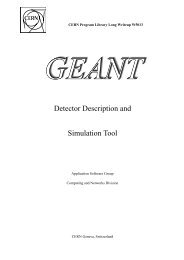Bone Marrow Register - Collection.europarchive.org
Bone Marrow Register - Collection.europarchive.org
Bone Marrow Register - Collection.europarchive.org
You also want an ePaper? Increase the reach of your titles
YUMPU automatically turns print PDFs into web optimized ePapers that Google loves.
You could save even<br />
more lives, join the...
As a blood donor, you already provide<br />
a vital service to patients who need<br />
blood, and by registering with the<br />
British <strong>Bone</strong> <strong>Marrow</strong> Registry you could<br />
help people even more.<br />
What is bone<br />
marrow<br />
<strong>Bone</strong> marrow is a soft tissue found<br />
in the centre of certain bones in your<br />
body. It is this bone marrow which<br />
creates stem cells. Stem cells are the<br />
‘building blocks’, which can grow into<br />
any of the other normal blood cells<br />
such as red cells, which carry oxygen;<br />
white cells, which fight infection, or<br />
platelets which stop bleeding.<br />
2<br />
Hamzah’s story<br />
Within just a month of joining the<br />
BBMR, Hamzah was found to be a<br />
match for a recipient and donated<br />
life-saving bone marrow. He says<br />
“I would do it again, and I would<br />
encourage more people from ethnic<br />
communities to register”.<br />
Why do we need<br />
bone marrow/<br />
stem cell donors<br />
There are a number of diseases<br />
that prevent a patient’s bone marrow<br />
from working properly. These include<br />
leukaemia and aplastic anaemia as well<br />
as other diseases of the immune system.<br />
Although chemotherapy will<br />
successfully treat some of these<br />
patients, for many the only possibility<br />
of a cure is to have a stem cell<br />
transplant from a healthy donor. In<br />
about 30% of cases, a matched donor<br />
can be found from within the patient’s<br />
family, such as a brother or sister.
Sarah<br />
Thompson<br />
(Patient)<br />
The other 70% of patients have to<br />
rely on a matched volunteer donor,<br />
identified through The British <strong>Bone</strong><br />
<strong>Marrow</strong> Registry (BBMR). We need<br />
to continue to recruit more donors,<br />
particularly from ethnic communities.<br />
This is important as finding a suitable<br />
match, whenever a bone marrow/stem<br />
cell transplant is needed, is often<br />
difficult due to the lack of appropriate<br />
volunteers on the Registry.<br />
What is the British<br />
<strong>Bone</strong> <strong>Marrow</strong><br />
Registry<br />
The British <strong>Bone</strong> <strong>Marrow</strong> Registry is a<br />
division of the National Blood Service,<br />
working in co-operation with the other<br />
UK bone marrow/blood donor registries<br />
and the NHS Cord Blood Bank. Stem cell<br />
donations from cord blood can be made<br />
at specialist hospitals within the NHS.<br />
For more information see<br />
www.nhscordblood.co.uk.<br />
The BBMR holds details of stem cell<br />
donors and cord blood donations<br />
from England, Scotland, North Wales<br />
and Northern Ireland. It is responsible<br />
for recruiting, testing and registering<br />
blood donors who volunteer to become<br />
stem cell donors. It is also part of an<br />
international network, performing<br />
searches around the world to find<br />
suitable stem cell donors.<br />
How can I join the<br />
register<br />
You must be aged between 18 and 49<br />
years old (registered before your 50th<br />
birthday) and be a blood donor. You<br />
can join when you next give blood, or<br />
at the same time as your first donation.<br />
We will check that there is no medical<br />
reason preventing you from being both<br />
a blood donor and a stem cell donor.<br />
At the time of your blood donation we<br />
will take an extra blood sample, so that<br />
we can identify your tissue type for the<br />
registry from your DNA – the genetic<br />
material our bodies are made up from.<br />
Please inform the staff at the blood<br />
donation session that you wish to join<br />
the BBMR before your blood donation<br />
is taken. The consent form attached to<br />
this leaflet must be completed at that<br />
time and handed to the member of<br />
staff collecting your blood donation.<br />
Please ask a staff member for a copy<br />
of the form if it is not attached.<br />
www.bbmr.co.uk<br />
3
A micrograph<br />
scan of a stem<br />
cell sitting in<br />
the eye of a<br />
needle.<br />
The register<br />
We will confirm we have received<br />
your sample and once you have<br />
been approved to become a stem cell<br />
donor your details and tissue type will<br />
be put onto the BBMR confidential<br />
computerised register.<br />
We will keep a sample of your DNA for<br />
up to 30 years in case of further, more<br />
detailed tissue typing, to confirm a<br />
match for a patient. Your details will<br />
be held in compliance with the Data<br />
Protection Act and your sample will<br />
not be used for any other tests, nor<br />
will your DNA be shared with any other<br />
<strong>org</strong>anisation.<br />
Your details remain on the register until<br />
your 60th birthday. If at any stage you<br />
no longer qualify to give blood, please<br />
inform the BBMR as you may need to<br />
be taken off the register.<br />
You can ask for your name to be<br />
removed from the BBMR at any time.<br />
Please tell us if you change your<br />
personal details either when you attend<br />
a blood donation session or directly by<br />
calling the donor helpline on<br />
0845 7 711 711.<br />
<strong>Bone</strong> marrow stem cells. They are the building blocks<br />
which can grow into any of the normal blood cells. These<br />
can be red cells, or one of three types of white cells.<br />
4<br />
0845 7 711 711
Donors from ethnic<br />
communities<br />
Some tissue types are more common<br />
in certain ethnic groups of the<br />
population, meaning that a patient is<br />
more likely to be matched with a donor<br />
from a similar ethnic background.<br />
This also increases the chances of a<br />
successful transplant. The UK<br />
population is made up of people from<br />
many different ethnic communities.<br />
This wide range of tissue types may<br />
help to find potential stem cell donors<br />
for new patients who need transplants,<br />
both here in the UK and overseas.<br />
You are especially needed as a stem<br />
cell donor if you are from an African,<br />
African-Caribbean, Asian, Chinese,<br />
Jewish, Eastern European or<br />
Mediterranean community.<br />
What happens<br />
next<br />
Patients and potential donors are<br />
matched by comparing the white cells<br />
in the blood to reveal tissue types. If<br />
you are identified as a potential donor<br />
for a patient, we will contact you to<br />
talk you through the next steps, and<br />
ask you for a further blood sample for<br />
more extensive tissue typing. If you<br />
have any questions about this you can<br />
ask a member of registry staff.<br />
This is a serious commitment and you<br />
should consider the full implications<br />
for both you and the patient when you<br />
first complete the consent form and<br />
provide a blood sample for testing.<br />
If, however, you do not wish to proceed,<br />
you may withdraw at any stage.<br />
What happens if<br />
I am a match for<br />
a patient<br />
If you are identified as the best possible<br />
match with a patient, you will be invited<br />
to come into one of our Blood Donor<br />
Centres for an explanation of the<br />
procedures from one of our clinical staff.<br />
You will also have a thorough medical<br />
examination by a doctor and you will be<br />
asked to give your consent for a number<br />
of blood tests, to ensure there is no<br />
medical reason why you shouldn’t donate.<br />
Tim Wood<br />
(Patient)<br />
www.bbmr.co.uk 5
Claire’s story<br />
I joined the BBMR after seeing a<br />
leaflet at my usual blood donor<br />
session.<br />
After registering, it was two years<br />
until I was contacted. A few weeks<br />
after the donation I received a<br />
wonderful card through the BBMR,<br />
it was from the donor thanking me<br />
for their donation. You never know<br />
what might lie ahead of you and<br />
whether you might be the person<br />
praying for a match for a loved one.<br />
I feel very proud of my experience<br />
and thrilled that I have been able to<br />
save someone‘s life.<br />
How do I donate<br />
There are two possible ways of<br />
donating stem cells that you may<br />
be asked to consider.<br />
The first, and most frequently used, is<br />
to donate stem cells from circulating<br />
blood. For the four days preceding the<br />
donation a nurse will inject you with<br />
a drug, either at home, at your local<br />
Blood Donor Centre or at a local<br />
hospital. This drug vastly increases<br />
the number of stem cells in your<br />
circulating blood. On the fifth day you<br />
will have a blood test to check that<br />
you have enough circulating stem<br />
cells. You will then be connected to<br />
a cell-separator machine, without the<br />
need for a general anaesthetic. The<br />
machine collects the stem cells from<br />
your blood via a vein in one arm,<br />
returning the blood to your body<br />
through a vein in your other arm. If you<br />
are already a platelet donor you will be<br />
familiar with this type of machine.<br />
Occasionally you may be asked back on<br />
the sixth day for a further donation, if the<br />
dose of cells obtained is not sufficient.<br />
The second method is donation of bone<br />
marrow itself, which involves the removal<br />
of stem cells from your hip bones. This is<br />
done using a needle and syringe under<br />
a general anaesthetic in a hospital.<br />
Although this is not a surgical operation,<br />
there will be marks on the skin made by<br />
the needle. As there may be some<br />
discomfort where the needle has been<br />
inserted, you will need to stay in hospital<br />
for up to 48 hours and have a period of<br />
recovery at home of up to five days.<br />
6<br />
0845 7 711 711
Where will I make<br />
the donation<br />
Stem cell donations are given in<br />
hospitals or at one of our Blood Donor<br />
Centres and you can bring someone<br />
with you for support.<br />
After your<br />
donation<br />
For the first twelve months following<br />
your donation we will keep in contact<br />
to ensure you do not experience any<br />
adverse reactions. If you need to take<br />
time off work for the procedure you<br />
will be entitled to re-imbursement of<br />
expenses. These details will be covered<br />
in your medical interview when the<br />
procedures are explained.<br />
What are the risks<br />
Stem cell donation is very safe.<br />
However, no medical procedure is<br />
entirely without risk. Both forms<br />
of stem cell collection mentioned<br />
in this leaflet may involve some<br />
temporary discomfort in your bones<br />
and any small risks involved will be<br />
fully explained during your meetings<br />
with our staff.<br />
What information<br />
will I receive about<br />
the patient<br />
The identity and location of both the<br />
donor and the patient must remain<br />
confidential. We have a duty to take every<br />
precaution to avoid possible identity.<br />
This is to comply with ‘EU Tissue and Cells<br />
Directive (EUTCD)’. All you will know is<br />
that you are performing a very valuable<br />
and life saving procedure for a person<br />
who is in need.<br />
Stem Cell Registries<br />
<strong>Bone</strong> <strong>Marrow</strong> Donor Worldwide links<br />
bone marrow donor registries<br />
internationally using only tissue-typing to<br />
establish rapid identification of potential<br />
donors. You can be assured that your<br />
personal details are only available to the<br />
staff of the BBMR and are not available<br />
to international agencies.<br />
How can I get<br />
more information<br />
If you have any further questions, please<br />
contact the National Blood Service Donor<br />
Helpline on 0845 7 711 711.<br />
For general enquiries contact the<br />
National Blood Service Donor Helpline on<br />
0845 7 711 711 or visit www.bbmr.co.uk<br />
www.bbmr.co.uk 7
Sharonjeet’s story<br />
Sharonjeet was no more than eight<br />
months old when her parents first<br />
noticed a dramatic change in her<br />
personality. She had been a lively<br />
baby until then, bubbly and full of<br />
laughter. However, now she had no<br />
appetite, couldn’t stand being out of<br />
their arms, cried constantly and had<br />
a persistent, high temperature.<br />
Something was wrong, it wasn’t just<br />
teething trouble. Sharonjeet was<br />
admitted to Great Ormond Street<br />
Hospital where she was diagnosed with<br />
a very rare blood disorder. A fast acting,<br />
fatal childhood disease. Sharonjeet<br />
needed a stem cell transplant, but no<br />
match could be found.<br />
She underwent a year of chemotherapy<br />
before a non-related match was found<br />
and a transplant carried out.<br />
Sharonjeet is now a happy six year old.<br />
Her parents say they owe it all to stem<br />
cell donors.<br />
8<br />
0845 7 711 711
Olivia’s story<br />
In May 1998 Olivia changed from being<br />
a happy, playful toddler to being poorly,<br />
clinging to her mother and frequently<br />
crying. After developing nose bleeds and<br />
a rash, Olivia was in so much pain she<br />
was rushed to Kings Lynn Hospital. Her<br />
mother Karen recalls “Within two hours<br />
of seeing a doctor, we were told Olivia<br />
had acute lymphoblastic leukaemia”.<br />
During the following two years Olivia<br />
underwent intensive chemotherapy and<br />
needed frequent blood transfusions.<br />
By January 2001, after an apparent<br />
recovery, she developed a limp. After a<br />
worrying trip to the doctor her parents<br />
learned that the leukaemia had returned.<br />
Doctors suggested a stem cell transplant<br />
and miraculously a match was found<br />
within two months. Following a period of<br />
isolation and physiotherapy Olivia was well<br />
enough to play with other children again<br />
and today is a healthy 11 year old.<br />
Karen says “We are just so grateful to the<br />
bone marrow donor whose generosity has<br />
let Olivia grow into the bubbly little girl<br />
she is today”.<br />
www.bbmr.co.uk 9
Sarah’s story<br />
In May 2004, Sarah Thompson was<br />
looking forward to a summer<br />
wedding when she was rushed into<br />
hospital. Within just a few hours<br />
she was diagnosed with Leukaemia.<br />
Following four rounds of<br />
chemotherapy, Sarah, a teacher and<br />
life-coach, was in remission, and in<br />
March 2005 she married Mark.<br />
Sadly by Christmas of the same year<br />
the cancer had returned. Sarah<br />
was immediately booked in for<br />
further treatment, but her only<br />
hope for a full recovery was a stem<br />
cell transplant.<br />
Sarah and her family campaigned<br />
tirelessly to highlight the shortage of<br />
stem cell donors from ethnic minority<br />
groups and eventually a match was<br />
found. In November 2006 Sarah<br />
received her life-saving transplant.<br />
Now fully recovered Sarah is still<br />
working along with family and friends<br />
to encourage others to become<br />
donors. She says “I now appreciate life<br />
and live for the moment. If, due to our<br />
campaigning, one other life is saved,<br />
then the whole thing was worth it”.<br />
10<br />
0845 7 711 711
Personal details Please print clearly in black ink, using block capitals<br />
Title: Mr/Mrs/Ms/Miss/Other ______________________________________________________<br />
First name/s _____________________________________________________________________<br />
Last name ______________________________________________________________________<br />
Date of Birth (DD/MM/YY) _______________________________________________________<br />
Address _________________________________________________________________________<br />
_________________________________________<br />
Postcode _____________________________<br />
Home phone number ____________________________________________________________<br />
Work phone number ____________________________________________________________<br />
Mobile phone number ___________________________________________________________<br />
Email address ___________________________________________________________________<br />
Place of usual blood donation session _____________________________________________<br />
Are you a member of any other UK <strong>Bone</strong> <strong>Marrow</strong> Registry <br />
Eg Anthony Nolan Trust Yes No (Please tick one only)<br />
Ethnicity codes<br />
To which ethnic group do you consider that you belong<br />
WHITE<br />
1A UK/other Northern Europe<br />
1B Southern Europe<br />
1D Jewish<br />
1F Americas/Australia/New Zealand<br />
1G Mediterranean<br />
1H Other<br />
BLACK<br />
2I Africa<br />
2J Caribbean<br />
2K American<br />
2L Other<br />
ASIA & MIDDLE EAST<br />
1C Middle Eastern Arab<br />
1E India<br />
1E Pakistan<br />
1E Bangladesh<br />
3M Chinese<br />
3M Japanese<br />
3O Nepalese/Burmese/Thai/Indonesian<br />
3P Other Asian/Middle Eastern<br />
OTHER<br />
4Q South America<br />
4R Hispanic<br />
4S Other<br />
www.bbmr.co.uk
<strong>Bone</strong> <strong>Marrow</strong> Registration and Consent<br />
To be completed by the donor and handed to a staff member<br />
I have read the information on this document and I agree that:<br />
1) A sample will be taken by the National Blood Service<br />
and tested to tissue-type my DNA and I agree for my<br />
details to be held on the British <strong>Bone</strong> <strong>Marrow</strong> Registry. Yes No<br />
2) My sample will be stored for up to 30 years to enable<br />
further tissue-typing for a potential match. Yes No<br />
3) I may be approached by the BBMR regarding<br />
participation in ethically approved research projects. Yes No<br />
4) The residual blood/DNA from my sample can be used for<br />
ethically approved, anonymous research projects. Yes No<br />
Signature _______________________________________________________________________________<br />
Name ____________________________________________ Date __________________________<br />
For NBS <strong>Collection</strong> Staff Use<br />
Date sample taken (DD/MM/YY)<br />
Donor ID number (if available)<br />
Pulse ID number (if available)<br />
For NBS Tissue Typing Laboratory Staff Use<br />
Donation Number Barcode<br />
(if available)<br />
Tissue Type Number_____________________________________________________________________________<br />
BBMR Donor ID Number (if available)<br />
Problem<br />
Date repeat sample requested (DD/MM/YY) ___________________________________________<br />
Date repeat sample taken (DD/MM/YY) _ _ _ _ _ _ _ _ _ _ _ _ _ _ _ _ _ _ _ _ _ _ _ _ _ _ _ _ _ _ _ _ _ _ _ _ _ _ _ _ _ _ _ _ _<br />
Data Protection<br />
All information and data processed by NHS Blood and Transplant is in accordance<br />
with the provisions of the Data Protection Act 1998.<br />
NHS Blood and Transplant<br />
The National Blood Service is part of NHS Blood and Transplant<br />
LC420P Printed on 55% recycled paper.<br />
INF/DDR/HI/001/04 Dec 07


